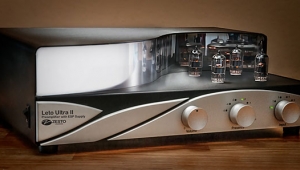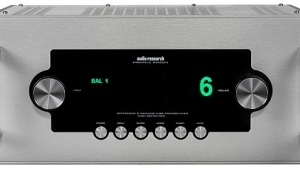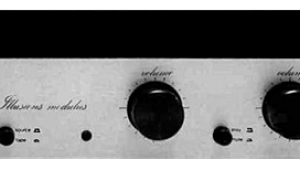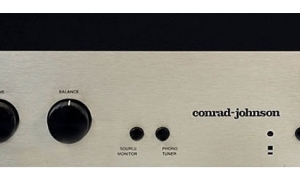| Columns Retired Columns & Blogs |
Balanced Audio Technology VK-5 preamplifier & VK-60/75 power amplifiers VK-60 amplifier in April 2000
Sidebar 3: Robert Deutsch wrote again about the VK-60 amplifier in April 2000 (Vol.23 No.4):
Time sure flies when you're having fun. Seems like yesterday, but it was actually more than four years ago (December 1995, to be precise) that I reviewed a preamplifier and power amplifier—the VK-5 and VK-60, respectively—from a promising new manufacturer, Balanced Audio Technology. But the design and manufacture of high-end audio equipment is not a guaranteed path to fame and fortune, and, looking at the table of contents of the December 1995 Stereophile, I note that four of the companies whose products were also reviewed in that issue have since bit the dust.
But not Balanced Audio Technology. Building on the success of the VK-5/VK-60 tube preamp/power amp combination, BAT has branched out in a sensible way with further preamplifier development (Jonathan Scull reviewed their latest, the VK-50SE, in December 1999), expanding their offerings to solid-state preamps and amps, and a CD player. And the company's ultra-high-end (projected retail: $10k-$12k) The AV-10 surround processor/preamp is expected to go into production this summer.
Throughout this period of growth, the VK-60 power amp has stayed in the line without any official updates (although, as we shall see, it has undergone some evolutionary development). Eagle-eyed readers may have noticed that the VK-60 did not appear on last October's "Recommended Components" list, which reflects Stereophile's policy that a listing is discontinued after three years unless at least one member of the magazine's staff has had some recent experience of the product. The VK-60 did not fulfill this criterion. When Jonathan Scull suggested that I do a Follow-Up, he didn't have to use even a fraction of his formidable powers of persuasion to convince me.
What's new?
It's pretty common knowledge that high-end audio manufacturers often revise their products without there being an official model change or "Mk.II/Improved/SE" designation. Manufacturers tend to keep quiet about these changes, for fear that they'll be inundated with requests for updates even when the changes are of the most inconsequential sort. But then, a series of changes, each of which might be exceedingly minor, can add up to something significant in the aggregate. In any case, the changes made in the VK-60 since the original version I reviewed in 1995 are:
• improved power-transformer design for greater mechanical stability, aimed at reducing mechanical hum or buzz;
• new rectifier filtering circuit to reduce power-supply noise and thereby improve S/N ratio;
• auto-bias circuit upgraded to improve performance;
• several small enhancements of the driver-tube power supply and protection circuits to further improve reliability;
• an additional upgrade to the protection circuit for the VK-60's output tubes, to protect the 6C33C-B tubes against almost any failure mode; and,
• to accommodate these changes, the current circuit board is in the sixth generation of revision.
A number of these changes, such as those made to the protection circuits, can be retrofitted to the older units at a nominal charge. (This is the sort of policy that contributes to building a loyal customer base.) The VK-60 is available in stereo or monoblock configuration for $4950 each, the price unchanged since 1996.
Hello, old friend
Listening to the VK-60 was like renewing an old friendship, confirming that all the things you admired about your friend are still there, and, if anything, have improved through the years. In my original review of the VK-60, I described it as having the tube "magic" without the deficiencies—insufficient power, weaknesses at the frequency extremes—which typically accompany that magic. That description also applies to the latest version of the VK-60. By "magic," I mean the ability to minimize the electronic/artificial aspects of reproduction—the ability to produce music rather than just sound. I have no problem listening to solid-state amplifiers, and can appreciate all they have to offer, but listening to a really good piece of tube gear—as the VK-60 assuredly is—reminds me that tubes are still the king when it comes to capturing the sort of relaxed liquidity that is part of the character of live music. It's a quality that draws you into the music rather than keeps you at a distance by highlighting the deficiencies in the process of reproduction. The pairing with the Dunlavy SC-IV/As (upgraded from the SC-IVs I had in 1995) was highly synergistic, the VK-60 softening the slight upper-midrange grain apparent when the Dunlavys are driven by most solid-state power amps. Low bass was still not a match to what you can get with solid-state, but was very good by tube standards.
Did the current VK-60 sound significantly better than the original VK-60? Not having the two side by side for comparison, and considering the fact that almost every part of my system has changed since 1995, I'm not in an ideal position to comment on how they differ sonically. However, my sense is that the new VK-60 was a little more transparent, tonally more neutral (less built-in warmth), and seemed more dynamic. It was definitely quieter mechanically, confirming BAT's claim about improved transformer design. Also, in my original review, I noted that a single-ended connection between the preamplifier and the VK-60 resulted in some fairly serious buzz/hum, which was reduced but not eliminated by lifting the AC ground on the amplifier. The new VK-60, driven by the latest version of the Convergent Audio Technology SL-1 preamp (which I had used back then), was much quieter, to the point that I had to put my ear to within about 6" of the midrange and the tweeter to hear any noise at all. And this was with the AC ground connected—a good thing, since lifting the AC ground presents a potentially serious shock hazard. Comparing these observations with my comments in the original review, it's clear that the current VK-60 has, indeed, a significantly better S/N ratio, confirming another claim about technical improvements.
According to Balanced Audio Technology's Steve Bednarski, the engineering changes incorporated into the VK-60 are not enough to merit a new model designation, and I'm not about to suggest to them that they call it the "VK-60i" and increase the price by $1000. What I do suggest is that the current VK-60 get ready to take its rightful place in Class A of "Recommended Components."—Robert Deutsch
- Log in or register to post comments




































